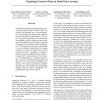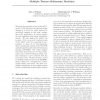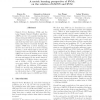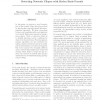JMLR
2012
12 years 1 months ago
2012
We study the problem of learning a group of principal tasks using a group of auxiliary tasks, unrelated to the principal ones. In many applications, joint learning of unrelated ta...
JMLR
2012
12 years 1 months ago
2012
Contextual bandit learning is a reinforcement learning problem where the learner repeatedly receives a set of features (context), takes an action and receives a reward based on th...
JMLR
2012
12 years 1 months ago
2012
We assess the generative power of the mPoTmodel of [10] with tiled-convolutional weight sharing as a model for visual textures by specifically training on this task, evaluating m...
JMLR
2012
12 years 1 months ago
2012
Support Vector Machines, SVMs, and the Large Margin Nearest Neighbor algorithm, LMNN, are two very popular learning algorithms with quite different learning biases. In this paper...
JMLR
2012
12 years 1 months ago
2012
Often when modeling structured domains, it is desirable to leverage information that is not naturally expressed as simply a label. Examples include knowledge about the evaluation ...
JMLR
2012
12 years 1 months ago
2012
In this paper, we propose a novel formulation of the network clique detection problem by introducing a general network data representation framework. We show connections between o...
JMLR
2012
12 years 1 months ago
2012
JMLR
2012
12 years 1 months ago
2012
One approach to modeling structured discrete data is to describe the probability of states via an energy function and Gibbs distribution. A recurring difficulty in these models is...
JMLR
2012
12 years 1 months ago
2012
JMLR
2012
12 years 1 months ago
2012
In this work, we propose a hierarchical latent dictionary approach to estimate the timevarying mean and covariance of a process for which we have only limited noisy samples. We fu...




